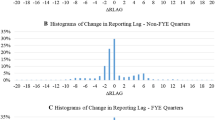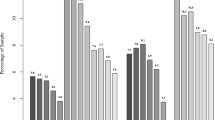Abstract
This study examines the information content of quarterly earnings announcements, measured as the magnitude of stock price revision at earnings announcements relative to price revision at other times. We investigate whether quarterly earnings announcements are informative using a nonparametric approach and 1971–2011 sample period. The findings affirm prior evidence on earlier sample periods that significantly more information is conveyed to investors in the three days around earnings announcements than in randomly chosen three-day periods. Next, we examine the behavior of information content over our sample period and document four key findings. First, there is a dramatic increase in information content at earnings dates from 2001 onward. Second, the market reaction to loss firms is substantially less than that for profitable firms. Third, there is a significantly greater reaction to larger firms. Fourth, reaction at earnings dates is significantly increasing in analyst coverage, and once analyst coverage is controlled, the association with size becomes less significant.







Similar content being viewed by others
Notes
We refer to the information content of earnings announcements rather than earnings as we study the reaction of prices on earnings announcement days, which will reflect the reaction to all information released on those days. This potentially includes information about the balance sheet and statement of cash flows as well as management guidance or other disclosures.
The U-statistic and the abnormal volume measures are based upon the notion that a necessary condition for a signal to have information content is that beliefs are altered and that the change in beliefs must be sufficient to alter actions across signals.
The difference between our measure TCU and the Landsman and Maydew measure LMU is that LMU implicitly assumes that daily returns are not correlated in both the estimation period and the testing period, whereas TCU does not make such assumptions. Our untabulated analysis indicates that the first-order serial correlation of daily returns is significantly negative in both the estimation and testing periods.
We focus on three-day rather than one-day returns for two reasons. First, prior studies use a three-day period and we wish to compare our results with theirs. Second, an examination of one-day returns would require the earnings announcements to be time-stamped to identify announcements that were made after the close of trading. The time stamp data is not available in computer-readable form until 1999.
Drawing the randomly chosen announcement date from the estimation period for each earnings announcement ensures that the randomly chosen date is from approximately the same calendar period as the actual earnings announcement date. Given that our sample is drawn over 41 calendar years, this procedure seems preferable to allowing the randomly chosen announcement date to occur at any time in the firm’s history.
Our convention of equating no coverage by IBES with no analysts’ coverage would contain substantial error if we included years prior to 1984, given the much less comprehensive sample available for earlier years. For firms that are not covered by IBES, we assume zero analyst coverage.
The pattern of the mean and medians of LMU is similar and, in the interests of brevity, are untabulated.
The retesting of the null hypothesis is also nontrivial in the sense that another 11 years have been added to the analysis, reflecting turbulent economic times and several regulatory changes. It is possible, although unlikely, that the information content may have declined sufficiently to be unable to reject the null. The retesting also shows that the TCU transformation of the U-statistic produces essentially the same results as research using common years.
References
Atiase, R. K. (1985). Predisclosure information, firm capitalization, and security price behavior around earnings announcements. Journal of Accounting Research, 23, 21–36.
Ball, R., & Brown, P. (1968). An empirical evaluation of accounting income numbers. Journal of Accounting Research, 6, 159–178.
Bamber, L., Christensen, T., & Gaver, K. (2000). Do we really “know” what we think we know? A case study of seminal research and its subsequent overgeneralization. Accounting Organizations and Society, 25, 103–129.
Barth, M. E., Beaver, W. H., & Landsman, W. R. (1998). Relative valuation roles of equity book value and net income as a function of financial health. Journal of Accounting and Economics, 25, 1–34.
Barth, M. E., Kasznik, R., & McNichols, M. (2001). Analyst coverage and intangible assets. Journal of Accounting Research, 39, 1–34.
Basu, S. (1997). The conservatism principle and the asymmetric timeliness of earnings. Journal of Accounting & Economics, 24, 3–37.
Bernard, V., & Thomas, J. (1989). Post-earnings-announcement drift: delayed price response or risk premium? Journal of Accounting Research, 27, 1–36.
Beaver, W. H. (1968). The information content of annual earnings announcements. Journal of Accounting Research, 6, 67–92.
Beaver, W. H., Corriea, M., & McNichols, M. (2012). Do differences in financial reporting attributes impair the predictive ability of financial ratios for bankruptcy? Review of Accounting Studies, 17, 969–1010.
Chen, S., DeFond, M., & Park, C. (2002). Voluntary disclosure of balance sheet information in quarterly earnings announcements. Journal of Accounting and Economics, 33, 229–251.
Collins, D. W., Li, O., & Xie, H. (2009). What drives the increased informativeness of earnings announcements over time? Review of Accounting Studies, 14, 1–30.
Collins, D. W., Pincus, M., & Xie, H. (1999). Equity valuation and negative earnings: the role of book value of equity. The Accounting Review, 74, 29–61.
DeFond, M., & Hung, M. (2003). An empirical analysis of analysts’ cash flow forecasts. Journal of Accounting and Economics, 35, 73–100.
Francis, J., Schipper, K., & Vincent, L. (2002a). Expanded disclosures and the increased usefulness of earnings announcements. The Accounting Review, 77, 515–546.
Francis, J., Schipper, K., & Vincent, L. (2002b). Earnings announcements and competing information. Journal of Accounting & Economics, 33, 313–342.
Givoly, D., & Hayn, C. (2000). The changing time-series properties of earnings, cash flows and accruals: has financial reporting become more conservative? Journal of Accounting and Economics, 29, 287–320.
Gow, I., Ormazabal, G., & Taylor, D. (2012). Correcting for cross-sectional and time-series dependence in accounting research. The Accounting Review, 85, 483–512.
Hayn, C. (1995). The information content of losses. Journal of Accounting and Economics, 20, 125–153.
Healy, P. (1985). The effect of bonus schemes on accounting decisions. Journal of Accounting and Economics, 7, 85–107.
Kasznik, R., & Lev, B. (1995). To warn or not to warn: management disclosures in the face of an earnings surprise. The Accounting Review, 70, 113–134.
Landsman, W. R., & Maydew, E. (2002). Has the information content of quarterly earnings announcements declined in the past three decades? Journal of Accounting Research, 40, 797–808.
Larcker, D. F., & Zakolyukina, A. (2012). Detecting deceptive discussion in conference calls. Journal of Accounting Research, 50, 495–540.
Miller, G. S. (2002). Earnings performance and discretionary disclosure. Journal of Accounting Research, 40, 173–204.
Ohlson, J. A., & Kim, S. (2015). Linear valuation without OLS: The Theil-Sen estimation approach. Review of Accounting Studies, 20, 395–435.
Patell, J. M. (1976). Corporate forecasts of earnings per share and stock price behavior: empirical tests. Journal of Accounting Research, 14, 246–276.
Patell, J. M., & Wolfson, M. (1982). Good news, bad news, and the intraday timing of corporate disclosures. The Accounting Review, 57, 509–527.
Shores, D. (1990). The association between interim information and security returns surrounding earnings announcements. Journal of Accounting Research, 18, 164–181.
Acknowledgements
The authors thank Jim Ohlson, Seil Kim, and an anonymous referee for their many helpful suggestions. The authors also appreciate the comments received from workshop and doctoral seminar participants at Stanford University.
Author information
Authors and Affiliations
Corresponding author
Appendices
Appendix 1: The Construction of TCU
For each earnings quarterly announcementi, we have the estimation period (EP) and the testing period (TP).
1.1 The Estimation Period (EP)
We define EP to be from trading day t − 130 to trading day t − 10and from trading dayt + 10 to trading day t + 130, where t is the day of earnings announcement We require the number of observations with nonzero returns in EP to be at least 40.
For TCU, we accumulate daily return data into three-day cumulative returns and run the market model with three-day cumulative returns. We obtain the estimates of α3day i andβ3day i , a3day i andb3day i . We then calculate the residual returns and the variance Var3dayμ.
1.2 The Testing Period (TP)
We define TP to be from trading day t − 1 to t + 1.
For TCU, we use a3day i and b3day i to calculate the three-day cumulative residual return μ3day i , t .
Appendix 2: The Nonparametric Procedure
-
Step 1: For each quarterly earnings announcement, we randomly draw a trading day from EP and call it the simulated nonreport announcement day. This stratified random sampling process would generate the same number of simulated nonreport-earnings announcements as the number of quarterly earnings announcements in our event sample. For each simulated nonreport announcement, we define the simulated nonreport estimation period (SNEP) to be from trading day t ' − 130 to trading day t ' − 10 and from trading day t ' + 10 to trading dayt ' + 130 . We require that the number of observations in SNEP to be at least 40. We define the simulated nonreport testing period (SNTP) to be from trading day t ' − 1 to t ' + 1. Here t 'is the day of the simulated nonreport earnings announcement.
-
Step 2: We calculate TCU for each simulated nonreport-earnings announcement using data from SNEP and SNTP. We then calculate TCU_mean and TCU_median for each calendar year.
-
Step 3: We repeat Step 1 and Step 2 for 1000 times and obtain the distributions of TCU_mean and TCU_median for each calendar year. Because these distributions do not use information from actual earnings announcements, they are the distributions under the null hypothesis that earnings announcements do not have information content.

Appendix 3
Rights and permissions
About this article
Cite this article
Beaver, W.H., McNichols, M.F. & Wang, Z.Z. The information content of earnings announcements: new insights from intertemporal and cross-sectional behavior. Rev Account Stud 23, 95–135 (2018). https://doi.org/10.1007/s11142-017-9417-z
Published:
Issue Date:
DOI: https://doi.org/10.1007/s11142-017-9417-z




